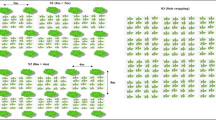Abstract
The aim of the present study was to evaluate and compare the effect of protected and open field cultivation on growth of Antirrhinum majus L. plants (selection UHFSA-13) through morphological parameters. The growing factors especially temperature and light were taken into consideration to interpret their effect on growth and flowering of the plants. The results revealed that protected cultivation enhanced plant height (81.42 cm), plant spread (42.84 cm) and number of spikes (12.29) as compared to open field cultivation (65.67 cm, 40.15 cm and 9.79, respectively). Further plants grown in naturally ventilated polyhouse led early bud formation (13–14 days) and flowering (7–8 days) with more number of florets per spike (23.96) as compared to plants grown under open conditions (17.89). When compared to open field production, naturally ventilated polyhouse achieved more number of pods per spike (20.08) with more number of seeds per pod (312.25), test weight of seeds (165.58 mg) and seed yield per plant (3.51 g) as compared to plants grown under open conditions (17.22, 310.63, 157.75 mg and 3.17 g respectively). Protected cultivation exhibited greater net return (Rs. 115.16/m2) and B:C ratio (1.0:4.45) as compared to open field cultivation (Rs. 55.63/m2 and 1.0:2.99 respectively). It is concluded that protected cultivation considerably enhances production of Antirrhinum as compared to open fields.


Similar content being viewed by others
References
Huxley A, Griffiths M, Levy M (1992) Antirrhinums. The new royal horticultural society dictionary of gardening, vol 1. Stackton Press, New York, pp 194–195
Cockshull KE (1985) Antirrhinum majus. In: Halevy AH (ed) Handbook of flowering, vol 1. CRC Press, Florida, pp 476–481
Hedley CL, Harvey DM (1975) Variation in the photoperiod control of flowering of two cultivars of Antirrhinum majus L. Annals of Botany 39:247–263
Hedley CL (1974) Response to light intensity and day length of two contrasting flower varieties of Antirrhinum majus L. J Hortic Sci 49:105–112
Andriolo JL (2000) Production physiology of horticulture in protected environment. Rev Hort Bras 18(1):26–32
Singh AK, Gupta MJ, Shrivastav R (2003) Effect of polyhouse on insect pest incidence, fruit quality and production of vegetable and fruit crops. Proceedings of the national symposium on frontier areas of entomological research, IARI, New Delhi, pp 94–95
Chandra P, Sirohi PS, Behera TK, Singh AK (2000) Cultivating vegetable in polyhouse. Indian Hortic 45(3):17–32
Sanderson KC, Link CB (1967) The influence of temperature and photoperiod on the growth and quality of winter and summer cultivar of Snapdragon, Antirrhinum majus L. Proc Am Soc Hort Sci 91:598–611
Lehman EL (2011) Fisher’s Testing Methodology, Fisher, Neyman, and the creation of classical statistics. http://www.springer.com/978-1-4419-9499-8. Accessed 12 December 2012
Institute SAS (1996) SAS/STAT User’s Guide, ver 6. SAS Institute, Cary, NC
Sa GD, Reghin MY (2008) Performance of two endive (Cichorium endivia L.) cultivars under three environments. Ciencia Agrotecnica 32(2):378
Gubbuk H, Pekmezci M (2004) Comparison of open-field and protected cultivation of banana (Musa spp. AAA) in the coastal area of Turkey. J Crop Hortic Sci 32(4):375–378
Pettersen RI, Gislerod HR (2003) Effects of lighting period and temperature on growth, yield and keeping quality of Gerbera jamesonii. European J Hort Sci 68:32–37
Smith H (1995) Physiological and ecological function within phytochrome family. Annu Rev Plant Physiol Plant Mol Biol 46:289–315
Rajapkse NC, Kelly JW (1993) Spectral filters influence transpiration water loss in chrysanthemum. Hort Sci 28(10):999–1001
Khattak AM, Pearson S (2005) Light quality and temperature effects on antirrhinum growth and development. J Zhejiang Univ Sci 68(2):119–124
Miller RO (1962) Variation in optimum temperatures of snapdragons depending on plant size. Proc Am Soc Hort Sci 81:535–543
Tayama HK, Miller RO (1965) Relationship of plant age and net assimilation rate to optimum growing temperature of the snapdragon. Proc Am Soc Hortic Sci 102:517–520
Edwards KJR, Goldenberg JB (1975) A temperature effect on the expression of genotypic differences in flowering induction in Antirrhinum majus. Ann Bot 40:1277–1283
Maginnes EA, Langhans RW (1961) The effect of photoperiod and temperature on initiation and flowering of snapdragon. Am Soc Hortic Sci 77:600–607
Singh B, Singh AK, Tomar B (2010) In peri-urban protected cultivation technology to bring prosperity. Indian Hortic 55(4):31–33
Gaikwad AM, Dumbrepatil SS (2001) Evaluation of chrysanthemum varieties under open and polyhouse conditions. J Orna Hortic New Ser 4(2):95–97
Acknowledgments
The present research had the financial support of Dr Y S Parmar University of Horticulture and Forestry, Nauni, Solan, Himachal Pradesh. The significant contribution of the Department of Floriculture and Landscaping researchers is acknowledged herewith. Further there is no conflict of interest either of co-authors for the content of this manuscript.
Author information
Authors and Affiliations
Corresponding author
Rights and permissions
About this article
Cite this article
Bhargava, B., Gupta, Y.C. & Sharma, P. Performance of Snapdragon (Antirrhinum majus L.) Under Protected and Open Field Conditions in Himachal Pradesh. Proc. Natl. Acad. Sci., India, Sect. B Biol. Sci. 86, 65–69 (2016). https://doi.org/10.1007/s40011-014-0406-8
Received:
Revised:
Accepted:
Published:
Issue Date:
DOI: https://doi.org/10.1007/s40011-014-0406-8




